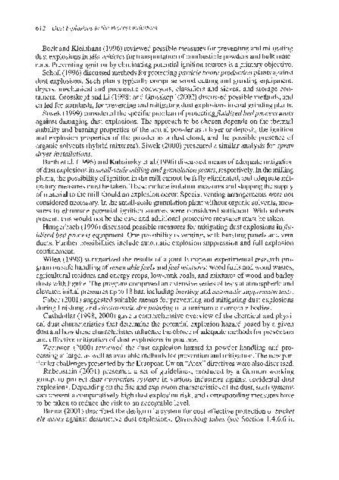Page 645 - Dust Explosions in the Process Industries
P. 645
6 72 Dust Explosions in the Process industries
Beck and Kleinhans (1996) reviewed possible measures for preventing and mitigating
dust explosionsin silo vehiclesfor transportation of combustible powders and bulk mate-
rials. Preventing ignition by eliminating potential ignition sources is a primary objective.
Scholl(l996) discussedmethods for protectingparticle boardproductionplants against
dust explosions. Such plants typically comprise wood cutting and grinding equipment,
dryers, mechanical and pneumatic conveyors, classifiers and sieves, and storage con-
tainers. Grosskopf and Li (1998) and Grosskopf (2002) discussed possible methods, and
called for standards,for preventing and mitigating dust explosions in coal grindingplants.
Siwek (1999) considered the specificproblem of protectingJEuidizedbedprocess units
against damaging dust explosions. The approach to be chosen depends on the thermal
stability and burning properties of the actual powder as a layer or deposit, the ignition
and explosion properties of the powder as a dust cloud, and the possible presence of
organic solvents (hybrid mixtures). Siwek (2000) presented a similar analysis for spray
dryer installations.
Barth et al. (1996) and Kubainsky et al.(1996)discussed means of adequate mitigation
of dust explosionsin small-scalemilling and granulationplants, respectively.In the milling
plants, the possibility of ignition in the mill cannot be fully eliminated, and adequate mit-
igatory measures must be taken. These include isolation measures and stoppingthe supply
of material to the mill should an explosion occur. Special venting arrangements were not
considered necessary. In the small-scale granulation plant without organic solvents,mea-
sures to eliminate potential ignition sources were considered sufficient. With solvents
present, this would not be the case and additionalprotective measures must be taken.
Hungerbach (1996) discussed possible measures for mitigating dust explosions inju-
idized bed process equipment. One possibility is venting, with bursting panels and vent
ducts. Further possibilities include automatic explosion suppression and full explosion
confinement.
Wilen (1998) summarized the results of a joint European experimentalresearch pro-
gram on safe handlingof renewablefiels andfiel mixtures: wood fuels and wood wastes,
agriculturalresidues and energy crops, low-rank coals, and mixtures of wood and barley
dusts with lignite.The program comprised an extensiveseries of tests at atmospheric and
elevatedinitialpressures up to 18bar, including inerting and automaticsuppression tests.
Faber (2001) suggested suitable means for preventing and mitigating dust explosions
during finishing and electrostatic dry painting of aluminum automobile bodies.
Cashdollar (1998,2000) gave a comprehensive overview of the chemical and physi-
cal dust characteristics that determine the potential explosion hazard posed by a given
dust and how these characteristicsinfluencethe choice of adequatemethods for prevention
and effective mitigation of dust explosions in practice.
Zeeuwen (2000) reviewed the dust explosion hazard in powder handling and pro-
cessing at large, as well as availablemethods for prevention and mitigation. The new par-
ticular challengespresented by the European Union “Atex” directiveswere also discussed.
Rabenstein (2001) presented a set of guidelines, produced by a German working
group, to protect dust extraction systems in various industries against accidental dust
explosions.Depending on the fire and explosioncharacteristicsof the dust, such systems
can present a comparativelyhigh dust explosionrisk, and correspondingmeasures have
to be taken to reduce the risk to an acceptable level.
Bunse (2001) described the design of a system for cost-effectiveprotection of bucket
elevators against destructive dust explosions. Quenching tubes (see Section 1.4.6.6 in

